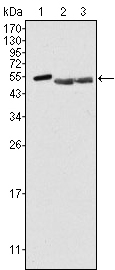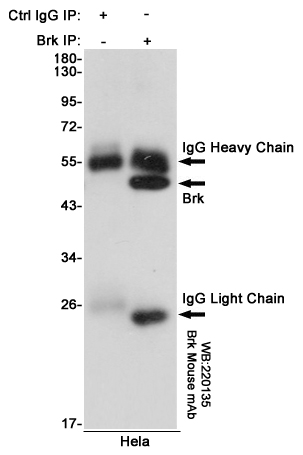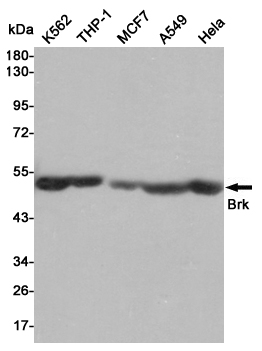-
Product Name
Anti-Brk/PTK6 (7D6) Mouse antibody
- Documents
-
Description
Brk/PTK6 (7D6) Mouse monoclonal antibody
-
Tested applications
WB, IP
-
Species reactivity
Human
-
Isotype
Mouse IgG2b
-
Preparation
Antigen: Purified recombinant fragment of human PTK6 expressed in E. Coli.
-
Clonality
Monoclonal
-
Formulation
Ascitic fluid containing 0.03% sodium azide.
-
Storage instructions
Store at 4°C short term. Store at -20°C long term. Avoid freeze / thaw cycle.
-
Applications
WB: 1/500 - 1/2000
ELISA: 1/10000
-
Validations

Western blot analysis using PTK6 mouse mAb against Hela (1), A549 (2) and MCF-7 (3) cell lysate.

Immunoprecipitation analysis of Hela cell lysates using Brk mouse mAb.

Western blot detection of Brk in K562,THP-1,MCF7,A549 and Hela cell lysates using Brk mouse mAb (1:1000 diluted).Predicted band size:52KDa.Observed band size:52KDa.
-
Background
Swiss-Prot Acc.Q13882.PTK6 (protein tyrosine kinase 6, BRK or FLJ42088), with 451-amino acid protein (about 52kDa), encods a cytoplasmic nonreceptor protein kinase which may function as an intracellular signal transducer in epithelial tissues. Its presence in the nucleus appears to be linked to suppression of tumor progression. The encoded protein has been shown to undergo autophosphory-lation. Very high level in colon and high levels in small intestine and prostate, and low levels in some fetal tissues. And Expressed at low level in some breast tumors, but not in normal breast. Also found in melanocytes, but not expressed in heart, brain, placenta, lung, liver, skeletal muscle, kidney and pancreas. Overexpression of this gene in mammary epithelial cells leads to sensitization of the cells to epidermal growth factor and results in a partially transformed phenotype.
Related Products / Services
Please note: All products are "FOR RESEARCH USE ONLY AND ARE NOT INTENDED FOR DIAGNOSTIC OR THERAPEUTIC USE"
